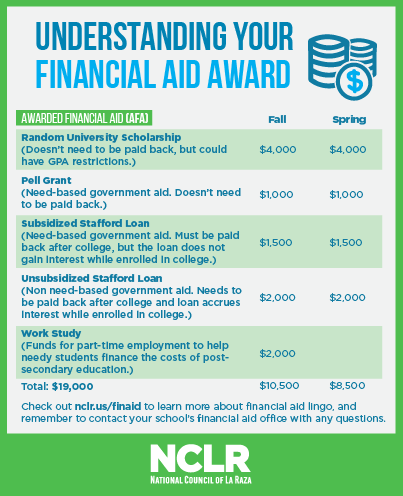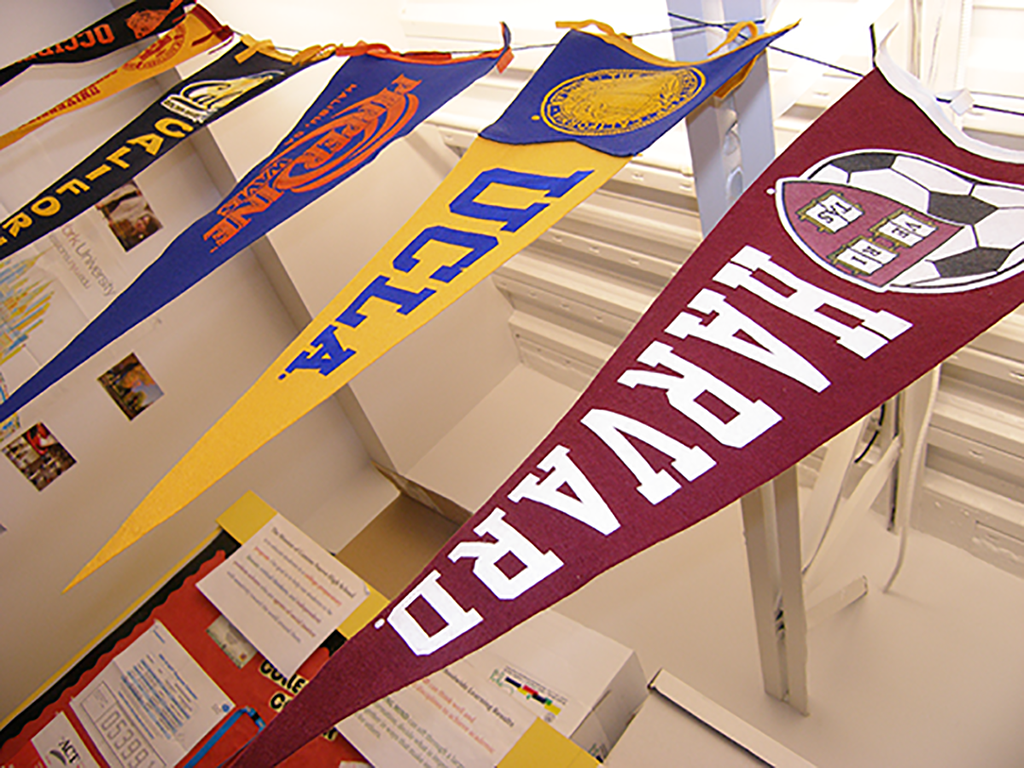Financial Aid and the Cost of College
For many Latino students and families, the cost of college is a major concern and perceived barrier. Most students are unaware of the types and sources of financial aid available and how to apply for them. This blog aims to provide information to help students understand financial aid and how it can help them achieve their dream of attending college.
See the infographic and glossary of terms below to help you navigate the world of financial aid.
Keep up with the latest from UnidosUS
Sign up for the weekly UnidosUS Action Network newsletter delivered every Thursday.
Financial Aid Glossary
Award Letter: Your award letter outlines the financial aid package being offered to you. You usually receive your award letter after you have completed the FAFSA (Free Application for Federal Student Aid) and have received your Student Aid Report (SAR).
Cost of Attending College: The cost of attending (COA) is the total cost of going to college, including tuition, room and board, books, transportation, fees, and personal expenses. Most two-year and four-year colleges will calculate your COA to show your total cost for the school year (for instance, for the fall semester plus the spring semester).
Demonstrated Need: This is the difference between the cost of attending a college and your Expected Family Contribution (EFC).
FAFSA: This is the Free Application for Federal Student Aid, a federal form required from all students who wish to apply for need-based financial aid, including grants, loans, and work-study awards.
Expected Family Contribution (EFC): The EFC is the amount of money students and their families are expected to contribute toward their education, as determined through a “need analysis” of information provided on a FAFSA.
Financial Aid Office: The office at the college or university campus that decides how much money a student will receive in grants and loans.
Room & Board: The cost of a room in a dormitory and a dining hall meal plan at a college or university.
Federal Pell Grant: This grant is a form of financial aid provided by the Federal government to students whose FAFSA indicates a high level of financial need. Unlike a loan, Federal Pell Grants do not have to be repaid.
Federal Perkins Loans: These loans are similar to Stafford loans in that no interest accrues while enrolled in college. At a five percent interest rate, the repayment grace period is longer than that of a Stafford subsidized loan. The need-based standards are more stringent for the Perkins loan and funds are awarded based on the FAFSA Student Aid Report.
Federal Work-Study Programs: The FWS Program provides funds for part-time employment to help students in need to finance the costs of postsecondary education. Most colleges offer work-study programs. The amount of financial aid provided to a student will vary, as will the size of the federal work-study award. It’s important to note that a student enrolled in a federal work-study program is unable to earn more than the size of the work-study award.
Grants: Grants, like loans and most scholarships, are based on financial need. A grant may be provided by federal or state governments, an institution, a foundation, or some other nonprofit funding source and does not have to be repaid.
Institutional Grant: This is a need-based grant provided by a college or university and offered to students whose families cannot pay the full cost of college. Institutional grants do not have to be repaid.
 Institutional Loan: Any student loan administered by the college or university using the institution’s funds as the source of funding. Perkins Loans may also be considered institutional loans.
Institutional Loan: Any student loan administered by the college or university using the institution’s funds as the source of funding. Perkins Loans may also be considered institutional loans.
Loans: A loan is a type of financial aid that is available to students and to the parents of students.
An education loan must be repaid. In many cases, however, payments do not begin until the student finishes school.
Merit-Based Grant: A form of gift aid (aid that does not require repayment) based upon your grade point average, academic excellence, and extracurricular involvement, with some attention to your financial need.
Need-Based Grant: This grant is offered, as a part of the financial aid package, when a student and his or her family are unable to pay the full cost of attending an institution. The grant does not need to be repaid.
Out-of–State (Non–Resident) Student: Student whose permanent residence is in a different state than that of the state-funded college or university which he or she attends or hopes to attend. Out‐of-state students generally pay higher tuition at state colleges and universities than do in-state students.
PLUS Loan: The Federal Parent Loan for Undergraduate Students (PLUS) allows parents, regardless of income, to borrow up to the total cost of education minus the amount of any other financial aid awarded by the institution or the government.
Scholarships: Financial aid that is awarded by schools, businesses, institutions, associations, and private industry that does not have to be repaid. Scholarships can be awarded based on need, academic merit, academic concentration, interests, or a host of other criteria.
Stafford Loan: A federal education loan that is funded and/or guaranteed and insured by the federal government. There are two types: subsidized and unsubsidized.
Subsidized Loan: A need-based loan on which the federal government pays accrued interest while the student borrower is in school, during the grace period, and during periods of deferment.
Unsubsidized Loan: A non-need-based loan for which the student is responsible for paying accrued interest.
Student Aid Report (SAR): This form will list the information you gave on the FAFSA and will give you a dollar amount for your Expected Family Contribution (EFC), which colleges use to determine your financial aid eligibility.
William D. Ford Direct Loan Program: A loan program administered by the U.S. Department of Education to provide loans that help students pay for their post-secondary education.


